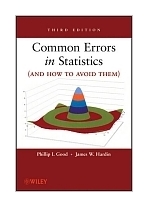|
||
• wydawnictwa polskie
• Zamów informacje o nowościach z wybranego tematu • kontakt
• Cookies na stronie |
COMMON ERRORS IN STATISTICS (AND HOW TO AVIOD THEM) 3RD EDITIONGOOD P.I. HARDIN J.W.wydawnictwo: WILEY , rok wydania 2009, wydanie IIIcena netto: Now in its Third Edition, the highly readable Common Errors in Statistics (and How to Avoid Them) continues to serve as a thorough and straightforward discussion of basic statistical methods, presentations, approaches, and modeling techniques. Further enriched with new examples and counterexamples from the latest research as well as added coverage of relevant topics, this new edition of the benchmark book addresses popular mistakes often made in data collection and provides an indispensable guide to accurate statistical analysis and reporting. The authors' emphasis on careful practice, combined with a focus on the development of solutions, reveals the true value of statistics when applied correctly in any area of research. The Third Edition has been considerably expanded and revised to include:
Providing valuable, up-to-date information in the same user-friendly format as its predecessor, Common Errors in Statistics (and How to Avoid Them), Third Edition is an excellent book for students and professionals in industry, government, medicine, and the social sciences. PHILLIP I. GOOD, PhD, is Operations Manager of Statcourse.com, a consulting firm specializing in statistical solutions for industry. He has published more than thirty scholarly works, more than six hundred popular articles, and twenty-one books, including Introduction to Statistics Through Resampling Methods and R/S-PLUS® and Introduction to Statistics Through Resampling Methods and Microsoft Office Excel®, both published by Wiley. JAMES W. HARDIN, PhD, is Research Associate Professor and Director of the Biostatistics Collaborative Unit at the University of South Carolina. Table of Contents
PREFACE. PART I FOUNDATIONS. 1 Sources of Error. Prescription. Fundamental Concepts. Ad Hoc, Post Hoc Hypotheses. To Learn More. 2 Hypotheses: The Why of Your Research. Prescription. What is a Hypothesis? Found Data. Null Hypothesis. Neyman–Pearson Theory. Deduction and Induction. Losses. Decisions. To Learn More. 3 Collecting Data. Preparation. Response Variables. Determining Sample Size. Sequential Sampling. One-Tail or Two? Fundamental Assumptions. Experimental Design. Four Guidelines. Are Experiments Really Necessary? To Learn More. PART II STATISTICAL ANALYSIS. 4 Data Quality Assessment. Objectives. Review the Sampling Design. Data Review. The Four-Plot. To Learn More. 5 Estimation. Prevention. Desirable and Not-So-Desirable Estimators. Interval Estimates. Improved Results. Summary. To Learn More. 6 Testing Hypotheses: Choosing a Test Statistic. First Steps. Test Assumptions. Binomial Trials. Categorical Data. Time-to-Event Data (Survival Analysis). Comparing the Means of Two Sets of Measurements. Comparing Variances. Comparing the Means of k Samples. Subjective Data. Independence Versus Correlation. Higher-Order Experimental Designs. Inferior Tests. Multiple Tests. Before You Draw Conclusions. Summary. To Learn More. 7 Miscellaneous Statistical Procedures. Bootstrap. Bayesian Methodology. Meta-Analysis. Permutation Tests. To Learn More. PART III REPORTS. 8 Reporting Your Results. Fundamentals. Descriptive Statistics. Standard Error. p-Values. Confidence Intervals. Recognizing and Reporting Biases. Reporting Power. Drawing Conclusions. Summary. To Learn More. 9 Interpreting Reports. With a Grain of Salt. The Analysis. Rates and Percentages. Interpreting Computer Printouts. To Learn More. 10 Graphics. The Soccer Data. Five Rules for Avoiding Bad Graphics. One Rule for Correct Usage of Three-Dimensional Graphics. The Misunderstood and Maligned Pie Chart. Two Rules for Effective Display of Subgroup Information. Two Rules for Text Elements in Graphics. Multidimensional Displays. Choosing Graphical Displays. Summary. To Learn More. PART IV BUILDING A MODEL. 11 Univariate Regression. Model Selection. Stratification. Estimating Coefficients. Further Considerations. Summary. To Learn More. 12 Alternate Methods of Regression. Linear Versus Non-Linear Regression. Least Absolute Deviation Regression. Errors-in-Variables Regression. Quantile Regression. The Ecological Fallacy. Nonsense Regression. Summary. To Learn More. 13 Multivariable Regression. Caveats. Correcting for Confounding Variables. Keep It Simple. Dynamic Models. Factor Analysis. Reporting Your Results. A Conjecture. Decision Trees. Building a Successful Model. To Learn More. 14 Modeling Correlated Data. Common Sources of Error. Panel Data. Fixed- and Random-Effects Models. Population-Averaged GEEs. Quick Reference for Popular Panel Estimators. To Learn More. 15 Validation. Objectives. Methods of Validation. Measures of Predictive Success. Long-Term Stability. To Learn More. GLOSSARY, GROUPED BY RELATED BUT DISTINCT TERMS. BIBLIOGRAPHY. AUTHOR INDEX. SUBJECT INDEX. 288 pages, Paperback Księgarnia nie działa. Nie odpowiadamy na pytania i nie realizujemy zamówien. Do odwolania !. |


